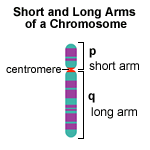Chromosome 1 (human)

Chromosome 1 is the designation for the largest human chromosome. Humans have two copies of chromosome 1, as they do with all of the autosomes, which are the non-sex chromosomes. Chromosome 1 spans about 247 million nucleotide base pairs, which are the basic units of information for DNA.[1] It represents about 8% of the total DNA in human cells.[2]
Identifying genes on each chromosome is an active area of genetic research. Chromosome 1 is currently believed to have 4,220 genes, exceeding previous predictions based on its size.[1] It was the last completed chromosome, sequenced two decades after the beginning of the Human Genome Project.
The number of single nucleotide polymorphisms (SNPs) is about 740,000.
Contents |
Genes
The following are some of the genes located on chromosome 1:
p-arm

- ACADM: acyl-Coenzyme A dehydrogenase, C-4 to C-12 straight chain
- COL11A1: collagen, type XI, alpha 1
- CPT2: carnitine palmitoyltransferase II
- DBT: dihydrolipoamide branched chain transacylase E2
- DIRAS3: DIRAS family, GTP-binding RAS-like 3
- ESPN: espin (autosomal recessive deafness 36)
- GALE: UDP-galactose-4-epimerase
- GJB3: gap junction protein, beta 3, 31kDa (connexin 31)
- HMGCL: 3-hydroxymethyl-3-methylglutaryl-Coenzyme A lyase (hydroxymethylglutaricaciduria)
- KCNQ4: potassium voltage-gated channel, KQT-like subfamily, member 4
- KIF1B: kinesin family member 1B
- MFN2: mitofusin 2
- MTHFR: 5,10-methylenetetrahydrofolate reductase (NADPH)
- MUTYH: mutY homolog (E. coli)
- NGF: Nerve Growth Factor
- PARK7: Parkinson disease (autosomal recessive, early onset) 7
- PINK1: PTEN induced putative kinase 1
- PLOD1: procollagen-lysine 1, 2-oxoglutarate 5-dioxygenase 1
- TSHB: thyroid stimulating hormone, beta
- UROD: uroporphyrinogen decarboxylase (the gene for porphyria cutanea tarda)
q-arm
- ASPM: a brain size determinant
- F5: coagulation factor V (proaccelerin, labile factor)
- FMO3: flavin containing monooxygenase 3
- GBA: glucosidase, beta; acid (includes glucosylceramidase) (gene for Gaucher disease)
- GLC1A: gene for glaucoma
- HFE2: hemochromatosis type 2 (juvenile)
- HPC1: gene for prostate cancer
- IRF6: gene for connective tissue formation
- LMNA: lamin A/C
- MPZ: myelin protein zero (Charcot-Marie-Tooth neuropathy 1B)
- MTR: 5-methyltetrahydrofolate-homocysteine methyltransferase
- PPOX: protoporphyrinogen oxidase
- PSEN2: presenilin 2 (Alzheimer disease 4)
- SDHB: succinate dehydrogenase complex subunit B
- TNNT2: cardiac troponin T2
- USH2A: Usher syndrome 2A (autosomal recessive, mild)
According to http://www.ornl.gov/sci/techresources/Human_Genome/posters/chromosome/chromo01.shtml the Chromosome 1 contains 263 million base pairs
Diseases & disorders
There are 890 known diseases related to this chromosome. Some of these diseases are deafness, Alzheimer disease, glaucoma and breast cancer. Rearrangements and mutations of chromosome 1 are prevalent in cancer and many other diseases. Patterns of sequence variation reveal signals of recent selection in specific genes that may contribute to human fitness, and also in regions where no function is evident. The following diseases are some of those related to genes on chromosome 1 (which contains the most known genetic diseases of any human chromosome):
- 1q21.1 deletion syndrome
- 1q21.1 duplication syndrome
- Alzheimer disease
- Alzheimer disease, type 4
- Breast cancer
- Brooke Greenberg Disease (Syndrome X)
- Carnitine palmitoyltransferase II deficiency
- Charcot-Marie-Tooth disease
- Charcot-Marie-Tooth disease, type 1
- Charcot-Marie-Tooth disease, type 2
- collagenopathy, types II and XI
- congenital hypothyroidism
- Deafness, autosomal recessive deafness 36
- Ehlers-Danlos syndrome
- Ehlers-Danlos syndrome, kyphoscoliosis type
- Factor V Leiden thrombophilia
- Familial adenomatous polyposis
- galactosemia
- Gaucher disease
- Gaucher disease type 1
- Gaucher disease type 2
- Gaucher disease type 3
- Gaucher-like disease
- Gelatinous drop-like corneal dystrophy
- Glaucoma
- Hemochromatosis
- Hemochromatosis, type 2
- Hepatoerythropoietic porphyria
- Homocystinuria
- Hutchinson Gilford Progeria Syndrome
- 3-hydroxy-3-methylglutaryl-CoA lyase deficiency
- Hypertrophic cardiomyopathy, autosomal dominant mutations of TNNT2; hypertrophy usually mild; restrictive phenotype may be present; may carry high risk of sudden cardiac death
- maple syrup urine disease
- medium-chain acyl-coenzyme A dehydrogenase deficiency
- Microcephaly
- Muckle-Wells Syndrome
- Nonsyndromic deafness
- Nonsyndromic deafness, autosomal dominant
- Nonsyndromic deafness, autosomal recessive
- Oligodendroglioma
- Parkinson disease
- Pheochromocytoma
- porphyria
- porphyria cutanea tarda
- popliteal pterygium syndrome
- prostate cancer
- Stickler syndrome
- Stickler syndrome, COL11A1
- trimethylaminuria
- Usher syndrome
- Usher syndrome type II
- Van der Woude syndrome
- Variegate porphyria
References
- ↑ 1.0 1.1 http://vega.sanger.ac.uk/Homo_sapiens/mapview?chr=1 Chromosome size and number of genes derived from this database, retrieved May 31, 2008.
- ↑ Gregory SG, Barlow KF, McLay KE, et al. (May 2006). "The DNA sequence and biological annotation of human chromosome 1". Nature 441 (7091): 315–21. doi:10.1038/nature04727. PMID 16710414.
Revera M et al. Long-term follow-up of R403WMHY7 and R92WTNNT2 HCM families: mutations determine left ventricular dimensions but not wall thickness during disease progression. Cardiovasc J Afr. 2007 May-Jun; 18(3):146-53.
External links
- National Institutes of Health. "Chromosome 1". Genetics Home Reference. http://ghr.nlm.nih.gov/chromosome=1. Retrieved May 17, 2006.
- Murphy WJ, Fronicke L, O'Brien SJ, Stanyon R (2003). "The origin of human chromosome 1 and its homologs in placental mammals". Genome Res 13 (8): 1880–8. doi:10.1101/gr.1022303. PMID 12869576.
- Schutte BC, Carpten JD, Forus A, Gregory SG, Horii A, White PS (2001). "Report and abstracts of the sixth international workshop on human chromosome 1 mapping 2000. Iowa City, Iowa, USA. 30 September-3 October 2000". Cytogenet Cell Genet 92 (1-2): 23–41. PMID 11306795.
- Reuters Wed May 17, 2006
- Final genome 'chapter' published BBC NEWS
|
||||||||